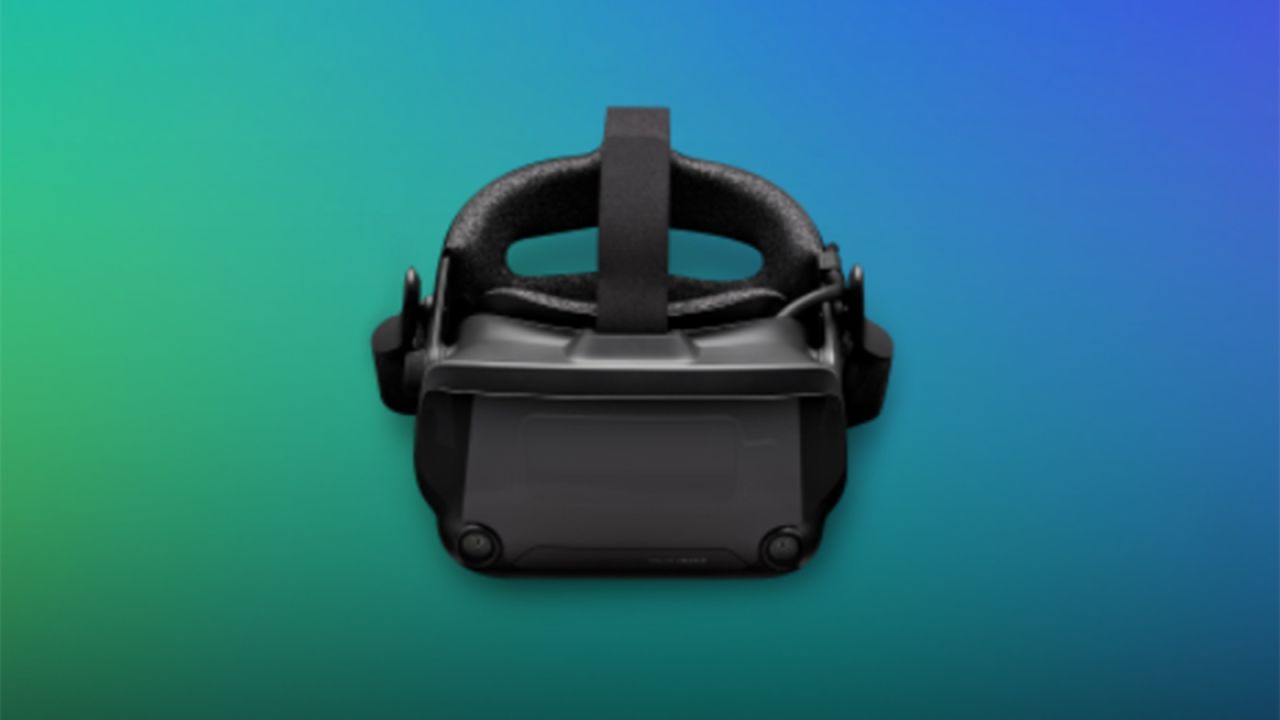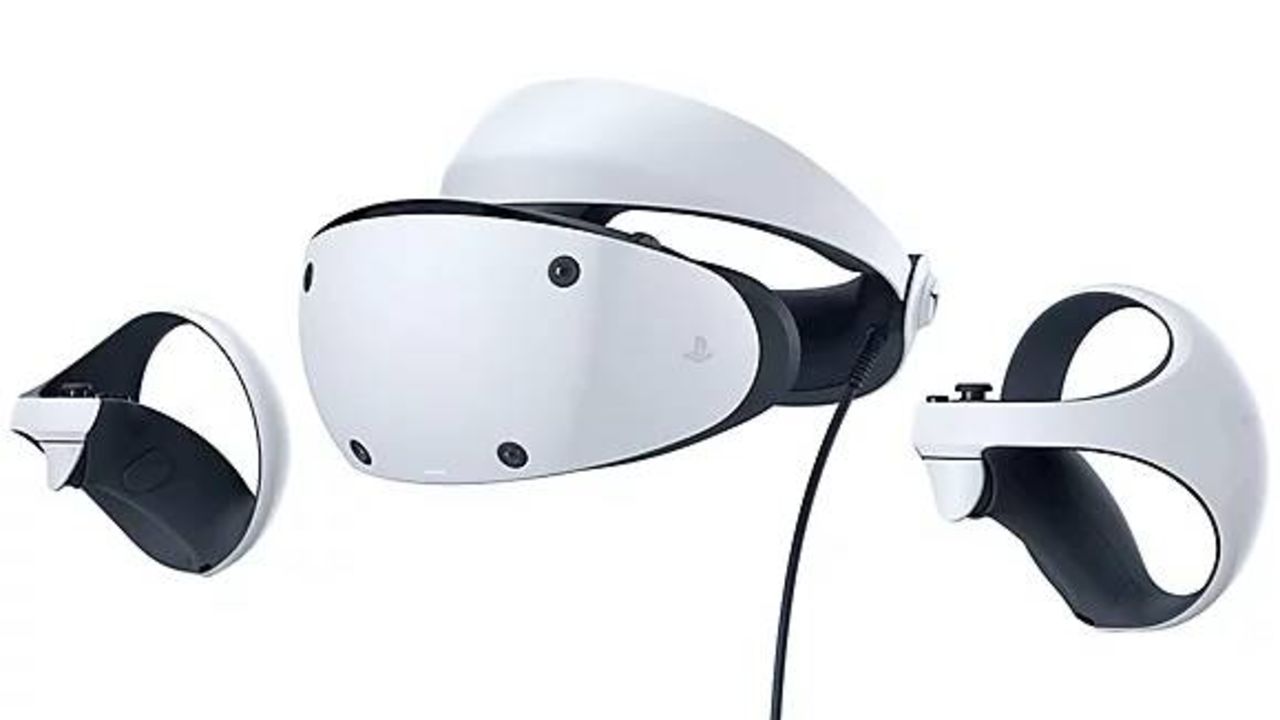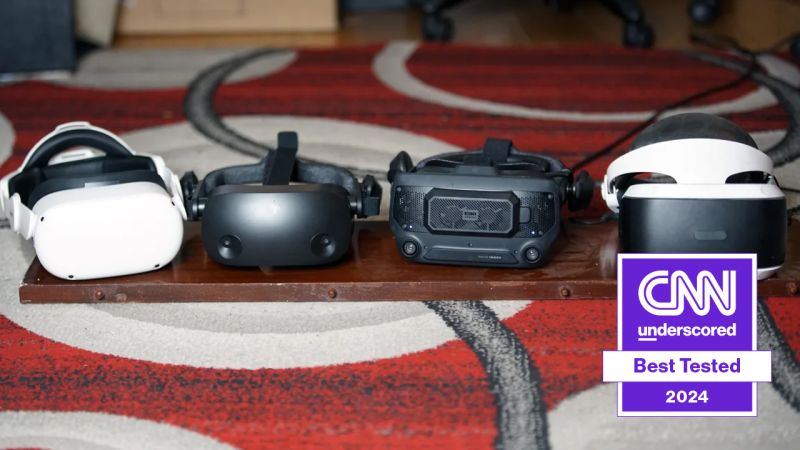There’s no better way to stretch the imagination than by immersing yourself in alternate universes with a great virtual reality headset. Between gaming, simulations and even fitness, VR has cemented itself as the future of digital interaction. Add the promise of the metaverse to the equation and VR will likely change how we interact with each other forever.
VR headsets range from affordable, stand-alone devices to high-end options designed to work with a powerful gaming PC. To help you find the best VR setup for your virtual journeys, we tested six leading models, spending weeks gaming, watching TV and even working in VR, and after all that we think Meta’s Quest 3 is the best VR headset out there.
With a slimmer design, faster performance and lots of welcome quality of life changes, the Meta Quest 3 improves on everything that made the Quest 2 our favorite VR headset for years — while also adding in mixed reality capabilities that can quite literally change the game.
In terms of design, there is no mistaking the Quest 3 for its predecessor. Its design is about 40% slimmer than its predecessor — which makes it even easier to toss in a bag when you’re traveling — though the three huge sensors up front give it a less clean look than the Quest 2. The new headset is technically a smidge heavier, but it actually feels more comfortable thanks to better overall weight balance. The new triangular adjustable strap took a bit of getting used to, but we now find it more comfortable and secure than that of the older model.
The new Touch Plus controllers also got a complete makeover, with a similarly slim design and more advanced haptics that better emulate the feel of everything from firing weapons to shaking maracas. Just note that they’re still powered by a single AA battery each and aren’t rechargeable; our controllers are still going strong after nearly a month of heavy use, but you may want to invest in rechargeable AA batteries (which come included in Meta’s $130 charging dock) if you don’t want to keep buying new ones.
The Quest 3’s biggest selling point is full color passthrough, which allows you to see your actual surroundings in fairly crisp detail whenever you need to quickly check on pets and kids — and enables a range of cool mixed reality experiences (First Encounters, which shows off the capabilities, comes preinstalled). The Quest 2 offers passthrough, but you’re limited to a grainy black-and-white image that’s not quite as intuitive for keeping tabs on your living room. This clear passthrough, combined with a more streamlined setup process that can now automatically create a virtual boundary for you to play in, make the Quest 3 even more pick-up-and-play than its predecessor.
From blasting zombies in our actual living room in Zombies: Noir to shooting holes in reality to let cute aliens through in First Encounters, all of the mixed reality experiences we tried worked well and felt novel. Rhythm games like Samba de Amigo: Party Central and Synth Riders cleverly imposed virtual objects atop our real world playspace as we flailed around. Even playing traditional VR games feels better on Quest 3, thanks to higher-resolution lenses and the new Snapdragon XR2 Gen 2 processor that promises twice the graphics performance. The serene vistas of the workout app Supernatural looked sharper than before, and triple-A games like Red Matter 2 flaunted noticeably more detailed environments.
The Quest 3 is fully backwards compatible with Quest 2 and Quest Pro games, meaning that anything you’ve purchased on the Meta store will come with you — something that gives the headset a major advantage over the PlayStation VR2 and its more rigid library. It’s also worth noting that, at least for now, all current and upcoming Quest games will continue to work on the Quest 2, just without the sharper visuals and mixed reality features made possible by the new headset.
Meta’s new headset isn’t without its drawbacks. Don’t expect better battery life, as the Quest 3 generally lasts the same two to three hours as its predecessor. And while the Quest 3 works with all your old games, its new design means that most of your existing Quest 2 accessories, like straps and face covers, won’t work on the new model (check out our picks for the best Quest 3 accessories, which include some cheap and easy upgrades). The fact that prices start at $500 for just 128GB of storage is a bummer, as you can get a 256GB Quest 2 for just $350. If you can live without mixed reality, the previous gen headset remains a great value that’ll continue to get access to all upcoming games.
Still, if it’s within your budget, the Quest 3 is the best VR headset you can currently buy. Its streamlined design, improved graphics and impressive mixed reality capabilities all make a big difference, and enhance what’s long been the best VR software library out there.
Best VR headset for PC gamers

An extraordinary audio/visual package, the Valve Index is the PC-based VR headset to get thanks to its excellent “knuckle” controllers and wealth of great software on SteamVR. It certainly helps that the excellent Half-Life: Alyx is included for free.
Best console VR headset

The PlayStation VR 2 is a huge improvement over its predecessor, offering the best console VR experience to date, thanks to its streamlined setup, immersive visuals and great controllers.
Most versatile VR headset

Featuring a high 2448 x 2448 per eye resolution within a seriously comfortable design, the HTC Vive Pro 2 is a worthy option for individuals with deep pockets. Unlike its PC-based competitors, the Vive Pro 2 offers add-ons such as body tracking and wireless functionality — if you’re willing to pay an extra fee.
| What we loved |
Sleek and comfortable design, fun mixed reality experiences and much improved performance. |
Smart and simple design that’s easy to set up, intuitive controllers and an incredible library of games. |
Outstanding design on both headset and controller fronts, immersive visual/audio presentation and strong game library. |
Great design and smooth setup, solid game library, useful Cinematic Mode |
Phenomenal comfort, high-resolution screen and legitimate versatility in customizing the experience. |
|---|---|---|---|---|---|
| What we didn’t like |
More expensive than the previous generation, battery life is still short |
Short battery life, price has gone up since launch |
A complicated setup and high price of entry. |
More expensive than original PSVR, lack of backwards compatibility, low battery life on controllers |
Beyond the complicated set up, the Vive controllers aren’t the best VR input method and the overall price is high. |
| Resolution |
2064 x 2208 per eye |
1832 x 1920 per eye |
1440 x 1600 per eye |
2000 x 2040 per eye |
2448 x 2448 per eye |
| Refresh rate |
Up to 120Hz |
Up to 120Hz |
Up to 144Hz |
Up to 120Hz |
Up to 120Hz |
| Wireless |
Yes |
Yes |
No |
No |
Wireless kit required |
| Required system |
None (optional PC compatibility) |
None (optional PC compatibility) |
Gaming PC |
PlayStation 5 |
Gaming PC |
| Price |
|
|
|
|
|
In terms of sheer performance and versatility, the Pimax Crystal is one of the best VR headsets we’ve tested yet. Games look and sound fantastic thanks to its rich 2880 x 2880 display and immersive DTS:X speakers, and it has the ability to function as both a standalone headset and one that you use with your gaming PC. However, its high price may be prohibitive for many, and the experience falls apart a bit once you go untethered.
PC gamers that are put off by the Valve Index and HTC Vive Pro 2’s higher price points and want something more powerful than the Meta Quest 2 should try HP’s Reverb G2. Expect an easier setup than other PC options, alongside an impressively high per-eye resolution. But, be wary that you will have to shell out more for the HP Reverb than for other models.
The original PlayStation VR was our previous console headset pick, thanks to a strong library of fun games and a useful Cinematic Mode for getting extra immersed in movies and standard PS4 games. However, its complicated setup process and mediocre performance are really showing their age, especially when the new PSVR 2 improves on the original in almost every meaningful way. The original PSVR still has a larger overall game library than the new headset, but if you have a PS5, you’re better off splurging for the new model.
The HTC Vive XR Elite is one of the most versatile and comfortable VR headsets we’ve tested, able to function as both a fully standalone headset as well as connect to your PC for use with the large library of Steam-based virtual reality experiences. However, its software selection is pretty middling if you’re not using it with a computer, and its controllers aren’t as intuitive as what you’ll get from rivals like the Meta Quest Pro and Valve Index.
Stand-alone vs. tethered
Some VR headsets require a gaming PC, while others are stand-alone units. Tethered models typically can run more processor-intensive games, support higher-resolution graphics and have better resolution, but they are harder to set up and more costly. Stand-alone units are less expensive, easier to use out of the box and don’t require any extra components. Our favorite stand-alone model, the Meta Quest 2, does support Quest Link for a more traditional PC gaming experience though, and some connected headsets can be used wirelessly; for example, a wireless kit is available for the HTC Vive Pro 2.
To use a PC-based VR solution, you’ll need a gaming console or powerful enough gaming rig. That means at least an Intel i5 or AMD Ryzen 1500 equivalent CPU, as well as an Nvidia GTX 970 or AMD RX 480 equivalent graphics card. The headsets are more expensive too, ranging from the $519 HP Reverb G2 to higher-end headsets like the HTC Vive Pro 2 and Valve Index that go well into the $1,000 range. Stand-alone models like the Meta Quest 2 cost less than $500.
Input is a huge part of the VR experience considering the amount of movement and prompts many games require. The Meta Quest 2 and HP Reverb G2 use similar controllers that feature three buttons, a thumbstick, a trigger and a grip on each controller in addition to things like accelerometers for motion tracking. This is probably the best way to ease console gamers into the experience — unlike the PlayStation Move or HTC Vive Controllers, which aren’t adequate for complex games due to a lack of inputs like thumbsticks. At the top of the VR controller heap are the Valve Index Controllers, which are pretty much the best money can buy with their excellent “knuckle” hand positioning, great button placement and rechargeable battery.
Immersion in VR comes from how convincing both the audio and visuals are. On the visual quality level, resolution and refresh rate are important factors besides other things like field of view. Resolution describes the number of vertical and horizontal pixels that can be displayed on a screen. The higher the resolution, the clearer the image quality. Refresh rate is how quickly the image can update on the screen. This means the higher the refresh rate, the smoother the image quality can be. On the lower level due to its stand-alone form factor, the Meta Quest 2 has an 1832 x 1920 per eye resolution with a 120Hz refresh rate which is respectable for what it can do. On the other hand, the PSVR is tied to aged hardware with a 960 x 1080 per eye resolution. The HTC Vive Pro 2 with its 2448 x 2448 per eye resolution represents the higher end of the spectrum.
How quickly you get to enjoying VR comes down to the setup. As mentioned previously, the Meta Quest 2 is a stand-alone device that can be hooked up to a gaming PC, but many users will likely use it wire-free. The only thing users have to do is set up a Meta account (separate from a Facebook account) and that’s about it. PC-based VR and PSVR have more complicated setups. The HP Reverb G2 and PlayStation VR 2 are the easiest tethered headsets to set up, as they just need to be connected to your PC or console via a single cable. Other tethered headsets like the HTC Vive Pro 2 and Valve Index also require at least two tracking sensors to be set up across from one another. PSVR owners have to connect the device through a processor box between their PS4 or PS5 and TV in addition to needing a PlayStation Camera.
A VR headset isn’t worth much if there isn’t any software available to play around with. Apps for various headsets usually fall into several categories including games, fitness, productivity and social.
When it comes to library size, The Meta Quest 2 has a lot going for it. There are hundreds of titles that average from free to around $39 alongside exclusive apps. This includes more traditional gaming experiences like Resident Evil 4 in addition to subscription-based fitness apps like Supernatural and FitXR. Through Quest Link connectivity to a gaming PC, the Meta Quest 2 can play larger Oculus games like Medal of Honor: Above and Beyond or use SteamVR for Half-Life: Alyx.
Users who want to go the PC-based tethered route can access Oculus games through a Steam add-on called Revive, which worked fine on the Valve Index and HTC Vive Pro 2 but not so well on the HP Reverb G2. Buyers who are looking to experiment with a variety of VR games without paying full price can subscribe to Viveport Infinity (which supports all PC-compatible options) for a monthly subscription price of $12.99. The PSVR 2 has a solid launch library headlined by games like Horizon: Call of the Mountain and Resident Evil Village; there’s no backwards compatibility with PSVR 1 games, though some titles such as Moss and Tetris Effect: Connected offer free or cheap upgrades to their new versions.
Our testing regimen for each headset lasted a little over a week. Some of the games tested included Medal of Honor: Above and Beyond, Asgard’s Wrath, Cooking Simulator VR, Space Channel 5 VR and Half Life: Alyx when utilizing the HP Reverb G2, Valve Index, HTC Vive and Meta Quest 2 via Quest Link. Games tested on the PSVR include Farpoint, Blood & Truth and The Walking Dead: Saints & Sinners. When testing the stand-alone Meta Quest 2 headset, we tried out software including Arizona Sunshine, Thrill of The Fight and Supernatural. For added measure, we tested battery life by running it from full battery to empty. For PC-based VR, we also used productivity apps like Virtual Desktop.
